
3D CT Scanner
These images can offer much more information than your typical x-ray, and grant us, your caregivers, another level of information to better treat you with.
This scanner can be used for all kinds of diagnoses and treatment planning, including impacted teeth, TMJ problems, reconstructive surgery, and even discovering jaw tumors. Let us put our technology to work for you in diagnosing your problems and giving you the treatment you need!

Virtual surgical treatment planning
Our virtual surgical treatment planning means simpler treatments and faster recovery for you. Using the information from your CT scan, among other things, we can plan out the procedures you need on an extremely accurate rendering of your mouth and jaw. It’s all customized to you!
There are incredible benefits to using this virtual planning. Any procedures that need doing will become that much less complicated when your surgeon can plan the process out ahead of time with a complete understanding of your individual jaw anatomy. This can be particularly useful in cases of implant positioning, multiple implants in a row, or when working with your jawbone itself.
With our virtual treatment planning, our dentist will have a clear idea of just what work will benefit your individual needs. This specialized care translates into faster, simpler treatments, and a better experience for you, our customer.
Contact us today to schedule an appointment or to learn more about the dental technology available to you!
[spoiler title=”Implant Technology” style=”simple” anchor=”implant-technology”]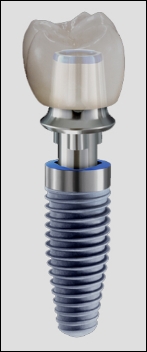 Dental implants are the most successful and cost effective treatment for missing teeth, a fact proven by hundreds of scientific studies. Their success rate, about 98% for most situations, is far superior to other treatments. Their longevity has been proven for over 45 years, and they can be expected to last about as long as natural teeth
Dental implants are the most successful and cost effective treatment for missing teeth, a fact proven by hundreds of scientific studies. Their success rate, about 98% for most situations, is far superior to other treatments. Their longevity has been proven for over 45 years, and they can be expected to last about as long as natural teeth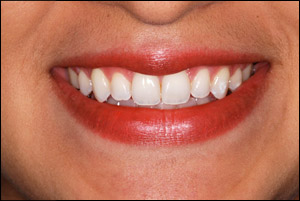
Dental Implant Anatomy
The best way to describe a dental implant is to compare it to a real tooth. The part of a natural tooth you can see is called the crown. Hidden beneath the gums is the root, which anchors the tooth to the jawbone.
A typical dental implant tooth is composed of three separate parts:
The actual implant is a titanium post that is surgically implanted into the jaw. After healing, the implant will completely fuse with the jawbone to function as a new root.
The abutment attaches to the implant, and serves as a connector between the implant and the crown.
The crown, which is custom fabricated by your restorative dentist, is fitted onto the abutment to recreate the natural shape and appearance of your tooth.
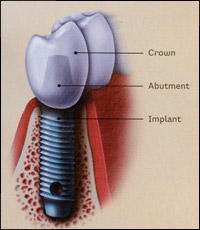

Depending on how many implants are placed, a single tooth, a segment of several implant-supported teeth, or even an entire set of new teeth can be made.
Problems Caused by Missing Teeth
If you lose one or more teeth, there are several unfortunate changes that begin immediately.
Atrophy of the Jaw Bone
When your tooth is gone, the jawbone is no longer stimulated by chewing forces, and the jawbone in the area begins to melt away – a process called atrophy. This progressive bone loss weakens the jawbone, and may complicate eventual implant placement.
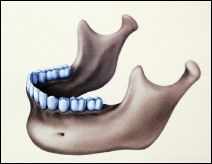


Drifting Teeth
Missing teeth also allow neighboring and opposing teeth to drift or tip into the emp
ty space. This creates orthodontic, gum, or cosmetic problems that may need to be corrected.
Accelerated Wearing Down of the Front Teeth
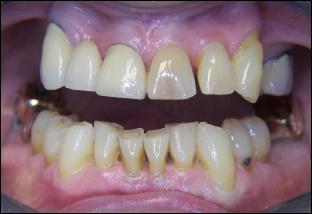 When back teeth are lost, the chewing force that was borne by the sturdy molar teeth is transferred to the more delicate front teeth. They become overloaded and wear down quickly, becoming shorter and shorter until they are lost altogether. The shape of the face also becomes more short and square because the jaws have developed an over-closed posture. This is why it is always best to have missing teeth replaced, even if they are unseen teeth in the back of the mouth.
When back teeth are lost, the chewing force that was borne by the sturdy molar teeth is transferred to the more delicate front teeth. They become overloaded and wear down quickly, becoming shorter and shorter until they are lost altogether. The shape of the face also becomes more short and square because the jaws have developed an over-closed posture. This is why it is always best to have missing teeth replaced, even if they are unseen teeth in the back of the mouth.
Problems with the Jaw Joint
When back teeth are lost, the missing support also places a heavy burden on the jaw muscles and joint structures. Over time, this can lead to clicking, popping, or grinding noises and can lead to jaw joint pain, locking, or degeneration (arthritis) of the joint.
Other Tooth Replacement Options
Although dental implants are a superior tooth replacement treatment, there are a few other options: a removable partial or full denture or a fixed bridge.
A removable partial denture fills in the missing teeth by resting on the gums while being held in place with metal prongs that clip onto the neighboring teeth. Full dentures replace all the teeth in one arch. Partials and dentures do not replace missing root structures or prevent further jawbone atrophy or tooth loss. They can be bulky and distort speech, and cosmetic results are disappointing if the metal prongs are visible. The fit of dentures tends to worsen as time goes by.
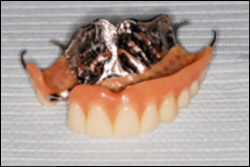
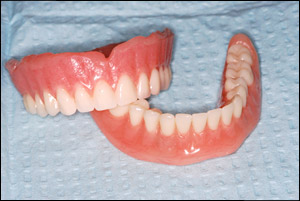
Removable partial and full dentures.
Fixed Bridge
A fixed bridge is made by shaving down and placing crowns on two teeth and suspending one or two false teeth in between. A bridge will last an average of 7-15 years before failing, often due to decay under one of the crowns. When a bridge eventually does fail, it usually means more teeth need to be extracted.
 Dental Implant Procedures
Dental Implant Procedures
Teeth In A Day
Dental Implant FAQ
[/spoiler]